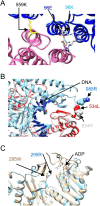Multiple gene sequencing for risk assessment in patients with early-onset or familial breast cancer
- PMID: 26824983
- PMCID: PMC4884994
- DOI: 10.18632/oncotarget.7027
Multiple gene sequencing for risk assessment in patients with early-onset or familial breast cancer
Abstract
Since BRCA mutations are only responsible for 10-20% of cases of breast cancer in patients with early-onset or a family history and since next-generation sequencing technology allows the simultaneous sequencing of a large number of target genes, testing for multiple cancer-predisposing genes is now being considered, but its significance in clinical practice remains unclear. We then developed a sequencing panel containing 68 genes that had cancer risk association for patients with early-onset or familial breast cancer. A total of 133 patients were enrolled and 30 (22.6%) were found to carry germline deleterious mutations, 9 in BRCA1, 11 in BRCA2, 2 in RAD50, 2 in TP53 and one each in ATM, BRIP1, FANCI, MSH2, MUTYH, and RAD51C. Triple-negative breast cancer (TNBC) was associated with the highest mutation rate (45.5%, p = 0.025). Seven of the 9 BRCA1 mutations and the single FANCI mutation were in the TNBC group; 9 of the 11 BRCA2, 1 of the 2 RAD50 as well as BRIP1, MSH2, MUTYH, and RAD51C mutations were in the hormone receptor (HR)(+)Her2(-) group, and the other RAD50, ATM, and TP53 mutations were in the HR(+)Her2(+) group. Mutation carriers were considered as high-risk to develop malignancy and advised to receive cancer screening. Screening protocols of non-BRCA genes were based on their biologic functions; for example, patients carrying RAD51C mutation received a screening protocol similar to that for BRCA, since BRCA and RAD51C are both involved in homologous recombination. In conclusion, we consider that multiple gene sequencing in cancer risk assessment is clinically valuable.
Keywords: BRCA; genetic counseling; hereditary breast cancer; multiple gene sequencing; variant of uncertain significance.
Conflict of interest statement
The authors declare they have no known conflicts of interest in this work.
Figures


References
-
- DeSantis C, Naishadham D, Jemal A. Cancer statistics for African Americans, 2013. CA Cancer J Clin. 2013;63:151–166. - PubMed
-
- Euhus D. Genetic Testing Today. Annals of surgical oncology. 2014;21:3209–15. - PubMed
-
- Locatelli I, Lichtenstein P, Yashin AI. The heritability of breast cancer: a Bayesian correlated frailty model applied to Swedish twins data. Twin Res. 2004;7:182–191. - PubMed
-
- Prokopcova J, Kleibl Z, Banwell CM, Pohlreich P. The role of ATM in breast cancer development. Breast Cancer Res Treat. 2007;104:121–128. - PubMed
Publication types
MeSH terms
Substances
Supplementary concepts
LinkOut - more resources
Full Text Sources
Other Literature Sources
Medical
Research Materials
Miscellaneous

